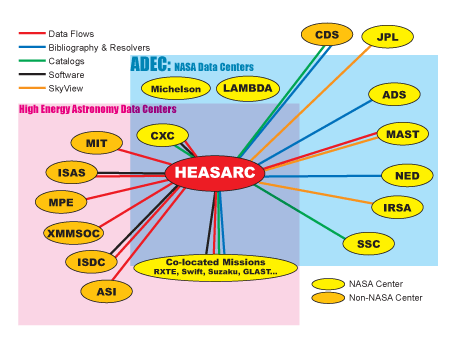A Brief History of the High Energy Astrophysics Science Archive Research Center
The HEASARC was established in November 1990 by NASA at its Goddard Space Flight Center as the designated archive for high-energy astrophysics (HEA) datasets from space-based observatories, and Dr. Nicholas White was appointed its director. It was the first of several wavelength-specific NASA science archive research centers. The motivation for these centers was to create an environment that could sustain archival data in usable form, after the mission that obtained these data ended. A crucial part of this new approach was to co-locate the archive with scientists actively undertaking research, connecting the data holdings with the necessary science expertise. It was also anticipated that a multi-mission approach to the archive would lead to cost savings for future missions by reusing software and archive resources.

The approach to data archiving pioneered by the HEASARC surpassed these original expectations. The technological advances in computers and mass storage over the past decade have helped the HEASARC to keep pace with its increasing data holding, within a relatively modest fixed budget. The dedicated research scientists and support staff are essential elements. The HEASARC success has been recognized by the subsequent establishment of Infra-red (IRSA), UV/optical (MAST) and Cosmic Microwave Background (LAMBDA) counterparts modeled along similar lines. Together with the Astrophysics Data System (ADS) and the NED/IPAC Extragalactic Database (NED), these four "active archive centers" plus the "deep archive" at the NSSDC now form the hub of the NASA (cosmic) astrophysics data infrastructure.
The HEASARC was selected as the first wavelength specific archive center because of the then imminent (as of 1990) ROSAT, CGRO, ASCA, and RXTE missions. These missions each had a unique and complementary capability that could only have been fully exploited if the data were stored within a single archive. Another concern at that time was that the data from several high energy astrophysics missions from the 1980s and 1970s were on the verge of being lost. The HEASARC therefore devoted resources to retrieving data from a number of these early missions (and, where necessary, converting them to modern formats), including OSO-8, HEAO-1, Einstein, and EXOSAT.
In the summer of 1999, with NASA HQ concurrence, the Harvard-Smithsonian Center for Astrophysics became a partner in the HEASARC organization. The primary objective of this partnering is to bring together the strengths and experience of both organizations to provide the best possible HEASARC service.
Since then, the HEASARC has provided access to data from a number of operational missions, including the BeppoSAX, Chandra, XMM-Newton, INTEGRAL, Swift Gamma-Ray Burst Explorer, Suzaku, Fermi and NuSTAR missions.
In the summer of 2008, the HEASARC merged with NASA's cosmic microwave background (CMB) archive LAMBDA (Legacy Archive for Microwave Background Data Analysis). The expanded HEASARC's data holdings thus now include data from the NASA CMB missions WMAP, COBE, and SWAS, as well as from ground-based and/or balloon-based experiments such as ACT and SPT.
In August 2008, Dr. Alan Smale succeeded Dr. Nicholas White as the Director of the HEASARC.
As of the time of writing (March 2016), the HEASARC's archive contains data from 32 HEA missions and 25 CMB experiments and/or missions. The HEASARC will continue to archive data from new and upcoming HEA missions, including Hitomi (formerly Astro-H) (launched in February 2016) and NICER (to be launched in early 2017) missions, and from additional CMB experiments, including BICEP/Keck, ACTpol and SPTpol.
